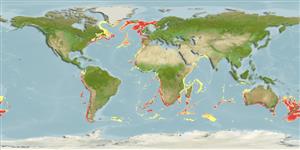分类 / Names
俗名 | 同种异名 | Catalog of Fishes(属, 种) | ITIS | CoL | WoRMS | Cloffa
Teleostei >
Trachichthyiformes (Roughies) >
Trachichthyidae (Slimeheads)
Etymology: Hoplostethus: Greek, hoplon = weapon + Greek, stetho, stethion = brest; literal = to prick a little breast (Ref. 45335).
Environment: milieu / climate zone / depth range / distribution range
生态学
海洋 深海区的; 海洋洄游的 (Ref. 51243); 深度上下限 180 - 1809 m (Ref. 6390), usually 400 - 900 m (Ref. 3583). 深水域; 3°C - 9°C (Ref. 36694); 65°N - 56°S, 84°W - 168°W
Western Atlantic: Gulf of Maine (Ref. 4784) [in error according to Moore (Fishes of the Gulf of Maine, in press), should be off northern Nova Scotia]. Eastern Atlantic: Iceland to Morocco; Walvis Bay, Namibia to off Durban, South Africa. Indo-Pacific: south-central Indian Ocean and New Zealand. Eastern Pacific: Chile (Ref. 27363). Several stocks may exist as suggested by distinct spawning sites and seasons.
西大西洋: 緬因灣 (參考文獻 4784)[錯誤根據摩爾 (緬因灣的魚, 在刊物), 應該是外海的新斯科舍省北部]. 東大西洋: 冰島到摩洛哥; 那米比亞的 Walvis 灣到外海的南非德爾班。 印度-太平洋: 印度洋中南部與紐西蘭。 東太平洋: 智利.(參考文獻 27363) 一些分枝可能存在當建議在明顯產卵區與季節之前。
Length at first maturity / 大小 / 重量 / 年龄
Maturity: Lm 34.5, range 18 - 32.5 cm
Max length : 75.0 cm TL 雄鱼/尚未辨别雌雄; (Ref. 36696); common length : 40.0 cm TL 雄鱼/尚未辨别雌雄; (Ref. 4181); 最大体重: 7.0 kg (Ref. 36697); 最大年龄: 149 年 (Ref. 3680)
背棘 (总数) : 4 - 6; 背的软条 (总数) : 15 - 19; 臀棘: 3; 臀鳍软条: 10 - 12. Bright brick-red in color, mouth and gill cavity bluish black (Ref. 4181). Ventral scutes: 19-25.
明亮的红砖色的颜色, 嘴与鳃腔蓝黑色的.(参考文献 4181) 腹面鳞甲: 19-25.
Inhabits deep, cold waters over steep continental slopes, ocean ridges and sea-mounts. Shallow range of usual occurrence from Ref. 27121. Appears to be dispersed over both rough bottoms and steep, rough grounds where it feeds on crustaceans and fish. In New Zealand, the main prey include mesopelagic and benthopelagic prawns, fish, and squid, with other organisms such as mysids, amphipods and euphausiids occasionally being important (Ref. 9072). Juveniles feed mainly on crustaceans (Ref. 27075, 27076). Grows very slowly and is one of the longest lived fish species known. Based on parasite and trace-element analyses, orange roughy is a sedentary species with little movement between fish-management zones (Ref. 27089). Little is known of the larvae and juveniles which are probably confined to deep water (Ref. 27088). The fishery targets sporadically formed dense spawning and non-spawning aggregations. Marketed fresh and frozen; eaten steamed, fried, microwaved and baked (Ref. 9988). Because of severe overfishing the species has been listed as threatened by the Australian Government in 2006.
深地栖息于, 在陡峭的大陆斜坡,海洋脊与海底山脉上的寒冷水域。 平常发生的水浅范围从参考文献 27121. 似乎散居在两者的之上粗糙的底部与陡峭的, 粗燥的底部在那里它吃甲壳类动物和鱼类。 在纽西兰,主要的猎物包括中层带与大洋底栖性鱼种虾,鱼与乌贼, 与其它的生物在一起例如糠虾,片脚类动物与磷虾偶然地是重要的.(参考文献 9072) 稚鱼主要捕食甲壳动物。 (参考文献 27075,27076) 非常慢慢地生长而且是一那生命最长的被知道的鱼种。 以寄生虫与痕迹为依据-要素分析, 橘色的 roughy 是有小的在魚-管理的區域之間的運動的一個定棲的種.(參考文獻 27089) 少為人知仔魚與稚魚可能那是侷限於深水域.(參考文獻 27088) 漁場目標偶而形成了密集的產卵與非被產卵的群集。 在市場上銷售生鮮和冷凍; 清蒸, 油炸, 微波了而且燒烤了.(參考文獻 9988) 由於嚴重的捕撈過度此魚種已經被列出當在 2006 年受到威脅的由於澳洲的政府.
Life cycle and mating behavior
成熟度 | 繁殖 | 产卵场 | 卵 | 孕卵数 | 仔鱼
Orange roughy are synchronous annual spawners (Ref. 7030). They form dense spawning aggregations over sea hills and slopes. Eggs and sperms are shed into the water at the same time. Individual males appear to spawn over a 1-2 week period and females spawn for up to 1 week. Little is known of the larvae and juveniles.西大西洋: 緬因灣 (參考文獻 4784)[錯誤根據摩爾 (緬因灣的魚, 在刊物), 應該是外海的新斯科舍省北部]. 東大西洋: 冰島到摩洛哥; 那米比亞的 Walvis 灣到外海的南非德爾班。 印度-太平洋: 印度洋中南部與紐西蘭。 東太平洋: 智利.(參考文獻 27363) 一些分枝可能存在當建議在明顯產卵區與季節之前。
Maul, G.E., 1986. Trachichthyidae. p. 749-752. In P.J.P. Whitehead, M.-L. Bauchot, J.-C. Hureau, J. Nielsen and E. Tortonese (eds.) Fishes of the north-eastern Atlantic and the Mediterranean. UNESCO, Paris. Vol. 2. (Ref. 4784)
世界自然保护联盟红皮书 (Ref. 130435: Version 2024-2)
人类利用
渔业: 高经济性
工具
特别资料
下载 XML
网络资源
Estimates based on models
Preferred temperature (Ref.
123201): 3.5 - 8.4, mean 6.6 °C (based on 754 cells).
Phylogenetic diversity index (Ref.
82804): PD
50 = 0.5000 [Uniqueness, from 0.5 = low to 2.0 = high].
Bayesian length-weight: a=0.02239 (0.01605 - 0.03122), b=3.08 (2.99 - 3.17), in cm total length, based on LWR estimates for this species (Ref.
93245).
营养阶层 (Ref.
69278): 4.3 ±0.1 se; based on diet studies.
回复力 (Ref.
120179): 非常低的, 最小族群倍增时间超过14 年 (K=0.04-0.06; tm=5-33; tmax=140; Fec=10,000).
Prior r = 0.07, 95% CL = 0.05 - 0.11, Based on 3 full stock assessments.
Fishing Vulnerability (Ref.
59153): High to very high vulnerability (72 of 100).
Climate Vulnerability (Ref.
125649): Moderate to high vulnerability (54 of 100).
Nutrients (Ref.
124155): Calcium = 12.4 [4.3, 62.9] mg/100g; Iron = 0.266 [0.095, 0.925] mg/100g; Protein = 17.5 [15.8, 19.2] %; Omega3 = 0.16 [0.05, 0.53] g/100g; Selenium = 20.4 [6.3, 69.4] μg/100g; VitaminA = 26.7 [2.7, 276.6] μg/100g; Zinc = 0.379 [0.183, 0.821] mg/100g (wet weight);
